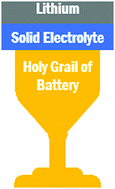The quest for the holy grail of solid-state lithium batteries
Abstract
Tremendous improvements in the Li+ conductivity of inorganic solid electrolytes over the past 15 years have renewed interest in developing solid state batteries, with a particular focus on realizing the lithium metal anode. Despite initial hopes, solid electrolytes pressed against flat lithium metal anodes have so far been unable to mitigate the penetration of the solid electrolyte by lithium dendrites. Our understanding of how lithium dendrites grow through solid electrolytes has also evolved. Based on the current literature, it appears that the root cause of lithium penetration is the low self-diffusion of Li0, coupled with lithium plating/stripping hot spots. Many different approaches to mitigate lithium penetration have been attempted. Some approaches, in particular, may warrant deeper insight, such as high-surface-area substrates for lithium deposition, lithium-alloys and artificial SEIs. Separately from the challenges of lithium metal, solid-state cathodes must contend with crack formation due to the expansion and contraction of the active material. Soft electrolytes, such as composite electrolytes, may be able to somewhat alleviate this. Herein we explain the challenges facing solid state cells, the attempts that have been made to mitigate them and our opinion of the most promising routes to success.

- This article is part of the themed collection: Energy and Environmental Science Recent Review Articles


 Please wait while we load your content...
Please wait while we load your content...